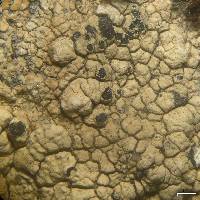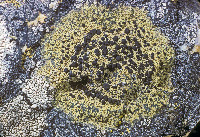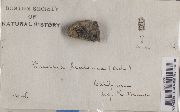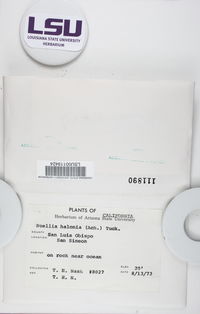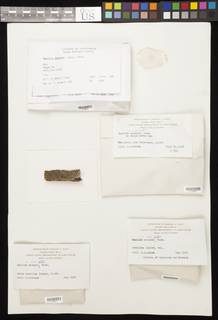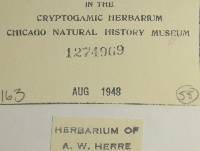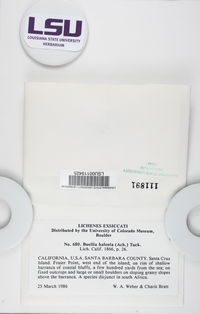
Consortium of Lichen Herbaria
- building a Global Consortium of Bryophytes and Lichens as keystones of cryptobiotic communities -
- Home
- Search
- Images
- Species Checklists
- US States: O-Z >
- US National Parks
- Central America
- South America
- US National Parks
- Southern Subpolar Region
|
|
|
|
Family: Caliciaceae
[Baeomyces capensis Taylor, moreDiploicia capensis (Taylor) C.W. Dodge, Lecidea halonia Ach.] |
Nash, T.H., Ryan, B.D., Gries, C., Bungartz, F., (eds.) 2007. Lichen Flora of the Greater Sonoran Desert Region. Vol 3. Thallus: crustose, areolate, thick, ±continuous; prothallus: distinct, delimiting the thallus as a black outline surface: usually yellowish green to pale yellow, rarely becoming brownish (older herbarium specimens), dull or ±shiny, smooth, epruinose, phenocorticate, esorediate medulla: white, but in the lower parts occasionally with a distinctly rust-red, K+ purplish pigment (possibly chiodectonic acid), lacking calcium oxalate (H2SO4-) Apothecia: lecideine; (0.2-)0.3-0.5(-0.7) mm in diam., initially immersed, young apothecia frequently ±aspicilioid, soon bursting through the thallus surface and becoming adnate to sessile margin: black, prominent, usually persistent, rarely excluded with age, at early stages often covered by coarse thallus fragments disc: black, epruinose or sometimes with yellowish pruina, plane, rarely becoming strongly convex with age proper exciple: distinct, leptocline-type, thick and not distinctly differentiated into an inner and outer part, hyphae thin-walled (mesodermatous), prosoplectenchymatous and usually ±densely interwoven (textura intricata), dull fuscous brown to aeruginose throughout, becoming ±carbonized by various amounts of brown and aeruginose pigments (cf. elachista-brown and cinereorufa-green, HNO3+ violet), aeruginose pigment not extending into the deep reddish brown hypothecium (leptoclinoides-brown, textura intricata) epihymenium: brown, pigmentation continuous with the outer exciple (HNO3-) hymenium: hyaline, not inspersed with oil droplets; paraphyses: simple to moderately branched, apically swollen, with a brown pigment cap (cf. elachista-brown) asci: clavate, Bacidiatype, 8-spored ascospores: soon brown, 1-septate, oblong to ellipsoid, usually not constricted, with obtuse ends, not curved, (11.5-)12.4-[14.1]-15.7(-19) x (6-)6.8-[7.4]-8(-9) µm (n=60); proper septum: becoming distinctly thickened during spore ontogeny (Physconia-type); ornamentation: weakly microrugulate (in DIC) Pycnidia: rare, urceolate to globose, unilocular; ontogeny similar to the Umbilicaria-type conidiogenous cells: mostly terminal, rarely also intercalary (cf. conidiophore-type V) conidia: bacilliform, 5-7 x 1-1.5 µm (n=20) Spot tests: K+ yellow, P+ orange, C+ orange, KC+ orange, CK+ orange fluorescence: UV+ bright yellow to orange iodine reaction: medulla non-amyloid Secondary metabolites: arthothelin, isoarthothelin, 2,4-dichloronorlichexanthone, 2,5-dichloronorlichexanthone, 2,7-dichloronorlichexanthone, 4,5-dichloronorlichexanthone, 4,5-dichloronorlichexanthone, 5,7-dichloronorlichexanthone, atranorin, thiophanic, thiophaninic, and norstictic acids, and eumitrin x and eumitrin y (J. A. Elix, HPLC). Substrate and ecology: epilithic, on siliceous mineral-poor coastal rock (generally HCl-) World distribution: the Pacific coast of North and South America; recently also found along the west coast of southern Africa (Namib Desert) Sonoran distribution: along the coast of southern California, Baja California, and Baja California Sur. Notes: Buellia halonia can be easily recognized by its yellowish green, C+ orange, areolate thallus, its thick, aeruginose exciple, and its spores with a conspicuously thickened septum. It is one of the few species of Buellia that often contain a rust-red, K+ deep purple pigment within its lower medulla. Until recently, this pigment was overlooked, as it is typically only observed if several areoles are sectioned. In Australia a very similar species has recently been described from inland localities as B. molonglo U. Grube & Elix (Grube et al. 2004). |
|
|
|
Powered by Symbiota



